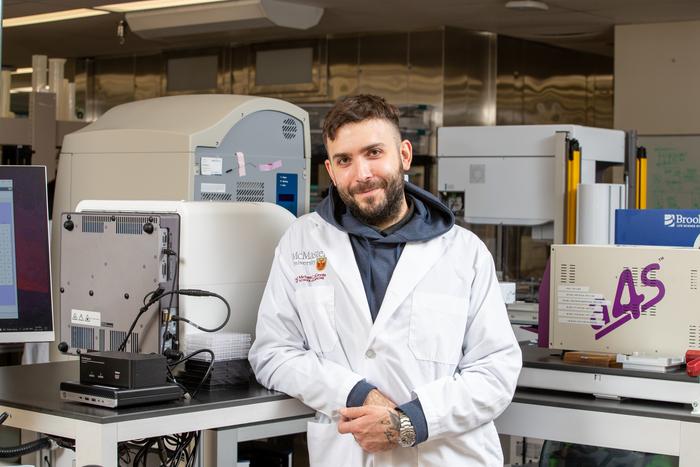Circular RNA Aptamers Reduce Alzheimer’s Neuroinflammation Effects
In a groundbreaking advance poised to reshape Alzheimer’s disease (AD) therapy, researchers have unveiled a novel approach targeting the molecular drivers of neuroinflammation using engineered circular RNAs. This innovative strategy hones in on the double-stranded RNA-activated protein kinase R (PKR), a critical enzyme implicated in the inflammatory cascade and neuropathological progression observed in AD. While […]


In a groundbreaking advance poised to reshape Alzheimer’s disease (AD) therapy, researchers have unveiled a novel approach targeting the molecular drivers of neuroinflammation using engineered circular RNAs. This innovative strategy hones in on the double-stranded RNA-activated protein kinase R (PKR), a critical enzyme implicated in the inflammatory cascade and neuropathological progression observed in AD. While previous attempts employing small-molecule inhibitors to mitigate PKR activity showed promise in preclinical models, their translation to effective treatments has been hampered by off-target toxicities and limited brain delivery. The current study harnesses the unique structural and functional advantages of circular RNA aptamers—engineered molecules designed to interact specifically with PKR—to effectively and safely dampen deleterious neuroinflammatory signaling within the Alzheimer’s brain.
Detailed investigations utilizing two distinct transgenic mouse models of AD demonstrated that the intracerebral administration of these double-stranded RNA-containing circular RNAs (ds-cRNAs) can substantially decrease aberrant PKR activation localized in neurons and microglia. The researchers employed adeno-associated virus (AAV) vectors to deliver the ds-cRNAs directly into the hippocampus, a region pivotal for learning and memory and severely affected during AD progression. This targeted suppression of PKR resulted in pronounced reductions of neuroinflammatory markers and amyloid-β plaque burden, pathological hallmarks notoriously linked to cognitive decline. Crucially, the treatment’s safety profile was favorable, showing minimal signs of neural toxicity or adverse immune responses, underscoring the therapeutic specificity and biocompatibility of engineered circular RNA elements.
One of the most compelling aspects of this work is the demonstration of effective systemic delivery of ds-cRNAs to the entire brain. Utilizing the AAV-PHP.eB serotype, capable of crossing the blood–brain barrier (BBB) upon intravenous injection, the team achieved widespread central nervous system transduction. This non-invasive delivery method resulted in broad attenuation of PKR-driven neuroinflammation and was accompanied by measurable improvements in spatial learning and memory across mouse cohorts at various stages of AD pathology. The capacity to circumvent the BBB—a formidable obstacle in neurotherapeutics—positions ds-cRNA-based treatment as a highly translational candidate with the potential to impact multiple brain regions implicated in AD.
The structural design of ds-cRNAs is a critical element underpinning their efficacy. Circular RNAs are inherently more stable than their linear counterparts, lacking free ends that are substrates for exonucleases. Incorporating short double-stranded motifs enables these circular RNAs to engage PKR directly, acting as aptamers that competitively inhibit the kinase’s proinflammatory activation without eliciting unintended immune activation. This specific structural mimicry offers potent suppression of PKR signaling pathways while minimizing collateral damage often observed with broad-spectrum small-molecule inhibitors. Such molecular finesse is particularly important for chronic diseases like AD where long-term safety and efficacy are paramount.
Further genetic and biochemical analyses revealed that PKR hyperactivity promotes an exacerbated neuroinflammatory milieu by amplifying microglial reactivity and downstream cytokine release, exacerbating amyloidogenic processes and synaptic dysfunction. By intercepting PKR activation, ds-cRNAs reduce these inflammatory circuits, fostering a neuroprotective environment that preserves neuronal integrity and connectivity. Importantly, this modulation does not completely abolish PKR’s physiologic roles but selectively intervenes in its pathologic overactivation, maintaining necessary cellular functions while curbing disease-driving inflammation.
The therapeutic impact of ds-cRNA administration was sustained impressively over extended periods. Mice receiving a one-time dose of AAV-delivered ds-cRNAs exhibited reduced neuroinflammation and plaque pathology for at least six months, corresponding with durable improvements in behavioral assays assessing hippocampus-dependent memory. This long-lasting effect raises the prospect that a single treatment could confer prolonged disease modification, a much-desired goal in AD therapeutics that currently relies on repeated dosing regimens with variable outcomes.
Notably, the intervention demonstrated efficacy at multiple stages of disease progression. Early, mid, and late-stage treated mice all exhibited amelioration of key pathological and cognitive symptoms, suggesting that ds-cRNAs could be applied flexibly in clinical scenarios ranging from early diagnosis to symptomatic management. This versatility contrasts with many contemporary AD treatments whose effectiveness diminishes once pathology is relatively advanced, underscoring the strategic advantage of directly targeting maladaptive neuroinflammatory signaling pathways.
Beyond the immediate implications for AD, the study’s successful repurposing of ds-cRNAs previously deployed in psoriasis models highlights a broader paradigm for targeting innate immune regulators via RNA aptamer technology. This modular platform enables rapid adaptation to diverse neuroinflammatory or autoimmune diseases, guided by precise molecular recognition principles. The convergence of RNA biology, viral vector engineering, and immunomodulation exemplified here signals an emerging frontier in precision neurotherapeutics.
While translation from murine models to human patients will necessitate comprehensive validation of safety, pharmacodynamics, and dosing regimens, the data provide a compelling rationale for clinical exploration. The use of adeno-associated viruses, already employed in several FDA-approved gene therapies, and the mechanistic specificity of ds-cRNAs collectively enhance the likelihood of regulatory and clinical success. Furthermore, improvements in vector design and delivery routes may optimize brain-wide distribution and target engagement in humans.
Mechanistic insights derived from this research also invite investigation into combinatorial strategies incorporating ds-cRNA aptamers alongside existing treatments such as anti-amyloid antibodies, tau-directed therapies, or symptom-targeting drugs. Synergistic modulation of multiple pathological axes may ultimately be required to arrest or reverse the complex cascade underlying Alzheimer’s disease. The precision inhibition of neuroinflammatory kinases like PKR sets a foundational milestone toward such multi-modal intervention.
In sum, the development of circular RNA aptamers capable of selectively targeting and inhibiting PKR within the Alzheimer’s brain represents a paradigm shift. By harnessing the intrinsic stability and binding specificity of engineered circular RNAs packaged within clinically relevant viral vectors, this approach offers a potent, durable, and minimally toxic means of curbing neuroinflammation and its downstream pathological consequences. As the global burden of AD continues to escalate, this innovative RNA-based platform may usher in a new wave of disease-modifying therapies addressing an urgent unmet medical need.
This landmark study not only advances our understanding of RNA therapeutic design but also illuminates novel molecular strategies to rein in the chronic neuroinflammatory state that drives neurodegeneration. The result is a hopeful horizon for patients, clinicians, and researchers alike, where targeted molecular therapies informed by cutting-edge bioengineering have the potential to reclaim cognitive function and quality of life from the grip of Alzheimer’s disease.
—
Subject of Research: Circular RNA aptamers targeting PKR to reduce neuroinflammation and ameliorate Alzheimer’s disease phenotypes in mouse models.
Article Title: Circular RNA aptamers targeting neuroinflammation ameliorate Alzheimer disease phenotypes in mouse models.
Article References:
Feng, X., Jiang, BW., Zhai, SN. et al. Circular RNA aptamers targeting neuroinflammation ameliorate Alzheimer disease phenotypes in mouse models.
Nat Biotechnol (2025). https://doi.org/10.1038/s41587-025-02624-w
Image Credits: AI Generated
Tags: adeno-associated virus deliveryAlzheimer’s disease therapyamyloid-β plaque reductionbrain delivery of therapeuticscircular RNA aptamerscognitive decline mechanismsengineered RNA moleculesneuroinflammation in Alzheimer’sneuroinflammatory signaling suppressionPKR enzyme inhibitiontargeted therapy for neurodegenerative diseasestransgenic mouse models of AD
What's Your Reaction?

































